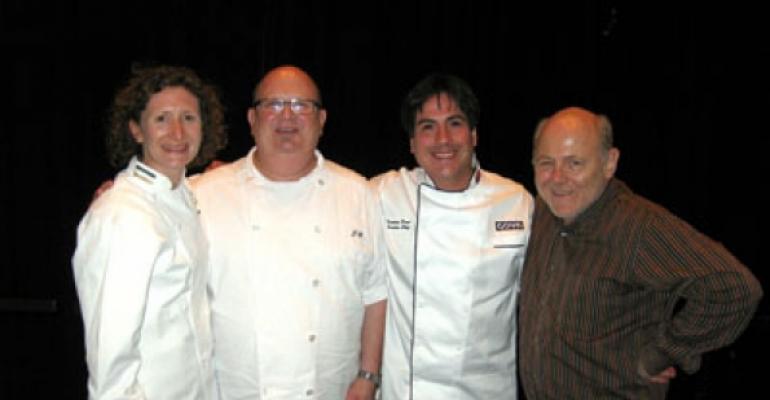Tapping into the Hispanic market, which is forecast to continue growing share in foodservice, requires thoughtful consideration of cultural and taste differences, experts said during a panel at last week’s Research Chefs Association conference.
In restaurants, Hispanic consumers tend to select more indulgent items than at home, said Jonathan Rogan, executive chef of El Pollo Loco, during the panel on “Developing Products for the Hispanic Market.”
Rogan was joined at the San Antonio conference panel by moderator Elizabeth Johnson-Kossick, chef instructor and Latin cuisine specialist at the Culinary Institute of America’s San Antonio campus, Fernando Desa, executive chef and product manager for Goya Foods Inc.; and Mark Miller, chef and author.
Miller said decision makers in Hispanic households tend to be mothers and grandmothers.
“In the Hispanic marketplace, the woman of the household generally makes almost all the decisions concerning children’s welfare,” he said. The women, he added, preserve the “tradition and identity of the family.”
Many of those matriarchs want their children to be bilingual, he added, so marketers would be wise to offer advertising and labeling in both Spanish and English.
EARLIER:
Eric Ripert: Diners want seasonal, sustainable foods
The restaurant customers of tomorrow
Panelists noted that the Hispanic population seems more prone to diabetes than the general population, so restaurants need to offer some healthful items.
“You have to offer healthy choices,” Rogan said. “However, the consumer tends to vote with their pocketbook, and they tend to go toward more indulgent. … On a day-to-day basis, we get this healthy halo from fire-grilled chicken. And it’s also authentic.”
Miller said he has observed new Chipotle restaurants in Albuquerque attracting a large number of Hispanic families, which he theorized was because of the “healthy glow” of natural foods.
“I think it comes down to value, flavor and, of course, perceived healthfulness are the three main pillars,” Rogan said on factors that appeal to the Hispanic consumer.
Continued from page 1
RCA panelists also noted:
Cultural differences: Miller had consulted with Darden Restaurants Inc., parent to the Red Lobster, Oliver Garden and LongHorn Steakhouse brands, about creating a Hispanic grill concept. The study found that “Hispanics don’t relate well to steakhouses in the tradition” of English motifs, he said. The study found about 200 values that Hispanics preferred over existing concepts, he added. “They are not cowboys,” he said. “They are not English gentlemen.”
“When you look at the Hispanic marketplace, you have to be very careful that you aren’t selling a product without that product being designed for their culture, for their social-psycho dynamic and for their value system,” Miller added.
Higher flavor profiles: “Hispanics like a lot of flavor in their food, and then the authenticity, meaning the presentation on the plate. And then the freshness,” said Desa of Goya. Rogan added that citrus is also appealing.
Trends on the horizon: “I think Peruvian is the next thing,” Desa said. “It has already started. It’s a fusion of Asian cuisine with a little Spanish cuisine. … There are a wide variety of chiles. There is also a lot of freshness with the fish. Besides that, there are the mango, the passion fruit. They are very tropical and refreshing. When you mix that with the chilies, you have an excellent combination.” Johnson-Kossick added that Peruvian food also has a lot of visual freshness and flavor profiles with pepper pastes.
Marketing: Brands that want to appeal more to Hispanic consumers might consider engaging in community events, such as church gatherings and holiday parades, the panelists agreed. Miller said when he consulted with Pei Wei Asian Diner, the fast-casual division of P.F. Chang’s China Bistro, he found that “community events are very powerful” to show support.
Risk-taking: Miller said that in consultations with Rubio’s, he encountered research that found that Hispanics, especially in California, were risk-takers and willing to try new things. Many are immigrants, he said, who have already taken the risk of leaving their homeland. “We find the immigrants are open to something that enlarges their view but respects who they are,” he said. However, “They do not want to be stereotyped,” he cautioned.
Contact Ron Ruggless at [email protected].
Follow him on Twitter: @RonRuggless

